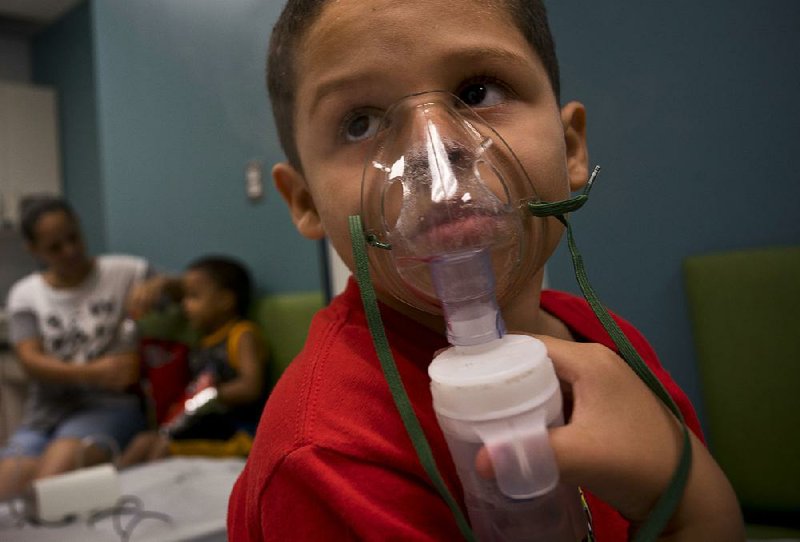SAN JUAN, Puerto Rico -- Shortly after he turned 2, Yadriel Hernandez started struggling to breathe. His doctor prescribed an inhaler and an allergy pill for asthma, and his symptoms were mostly under control.
Then Hurricane Maria devastated Puerto Rico, strewing mold-producing wreckage across the island and forcing many to use fume-spewing generators for power. The boy, now 8, started having twice-monthly attacks and needing nearly four times the amount of medicine he used to take.
His mother said weekly power failures in their coastal town of Aguadilla also feed his anxiety, which can make symptoms worse. He panics about not being able to turn on the plug-in nebulizer that helps control his attacks.
"The lights go out and he breaks down," said Johana Hernandez. "He cries out, 'The power is gone, mom! The power is gone! I'm going to have an asthma attack!'"
Doctors in Puerto Rico say they are seeing an alarming rise in the number and severity of asthma cases, which they attribute to destruction caused by the deadly hurricane that walloped the island in September. The chronic lung disease is caused by such things as pollution, airborne mold and pollen, all of which have increased post-Maria.
"It has increased so, so, so much after the hurricane," said Dr. Ivette Bonet, who treats low-income patients at a clinic in the working-class neighborhood of Santurce. Bonet says she has dozens of new patients who never had asthma before the Category 4 storm hit.
"Now they have this cough that they can never get rid of," she said.
Puerto Rico had high rates of asthma even before the hurricane. An estimated 435,000 people on the island of 3.3 million, or 13 percent, had asthma before Maria pummeled the territory on Sept. 20, according to Puerto Rico's Health Department. That compares with 8.3 percent who suffered from asthma on the U.S. mainland in 2016, according to the latest available figures from the U.S. Centers for Disease Control and Prevention. There are no figures for Puerto Rico in the months after Maria, though new accountings are under way.
Experts say the high rates may be partly due to the relatively high humidity in the Caribbean and the poor state of housing and infrastructure because of Puerto Rico's high poverty rate and bankrupt government.
Now, towering piles of building and plant debris from the hurricane remain in many neighborhoods.
Puerto Rico recorded the highest levels of mold spores in more than a decade in May, said Benjamin Bolanos, director of the San Juan Aeroallergens Station of the American Academy of Allergy, Asthma and Immunology. Heavy seasonal rains are contributing to the problem, he said.
"We have never seen something like this," Bolanos said.
Generators powered by diesel or gasoline, once used only in emergencies, belch fumes daily at hospitals, schools and water treatment plants because the power grid remains fragile and plagued by blackouts. Many are older models that don't meet current pollution standards. The U.S. Environmental Protection Agency waived those rules because of the power emergency, the first time it has made such an allowance, agency spokesman David Kluesner said.
Meanwhile, mold has invaded homes, especially the tens of thousands that still don't have a proper roof. And there's a problem with rats, mice and cockroaches, all of which can trigger an asthma attack.
Melissa Pesante says fumes from generators worsened her 5-year-old son's asthma and he spent nearly two weeks in a San Juan hospital. The family lives on the second floor above a home that runs a generator and across from an abandoned house where people keep dumping hurricane debris. Since the hurricane, her son has been prescribed additional medication and has attacks and trouble breathing several times a month, compared with hardly any attacks before the storm, she said.
"He's supposed to use a face mask, but he tells me, 'I don't like it, mom,'" and takes it off, Pesante said of the surgical mask her son is supposed to use whenever he goes outside.
She'd like to eventually join relatives in Orlando or Miami in hopes that her son's health and her finances will improve.
The situation is particularly bad on the islands of Vieques and Culebra, just east of Puerto Rico, that are still completely dependent on generators. Dr. Juan Manuel Roman travels to Culebra weekly and said that in addition to new patients, his regular patients are seeking treatment far more often. Roman said it's hard to escape the fumes from all the generators that keep the tiny island energized.
"They're always going to inhale them," he said.
A Section on 06/19/2018

